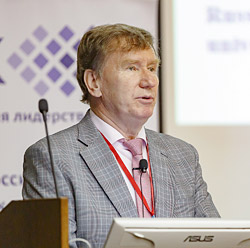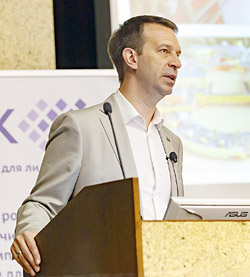
Electronic english version since 2022 |
The newspaper was founded in November 1957
| |
|
Number 28 (4676) |
Projects of the 21st century
The significance of the Conference
is always at a high level
On 3 - 7 July, the International Conference "Distributed Computing and Grid Technologies in Science and Education - GRID'2023" was held at JINR.
The Conference united specialists from Armenia, Azerbaijan, Belarus, Bulgaria, Czech Republic, Egypt, Georgia, Germany, Iran, Kazakhstan, Mexico, Moldova, Mongolia, Russia, Serbia, Uzbekistan and CERN. Over 200 participants gathered in Dubna and about 70 more specialists participated in the online event. Reports and posters were made by the staff of MSU, NRC "Kurchatov Institute", MIPT, ISP, IITP, KIAM, PNPI, IMPB, IHEP, MEPhI, RUDN University, RANEPA, Russian Quantum Centre, Federal Nuclear Centre, JINR, teachers and students of universities of Vladivostok, Vladikavkaz, Volgograd, Voronezh, Dubna, Irkutsk, Kazan, Moscow, Samara, St. Petersburg, Tver, Tula. The Conference programme covered the topics of heterogeneous supercomputers, quantum informatics and quantum computing, distributed computer systems, computing for mega-science projects, big data, machine learning and artificial intelligence, cloud technologies.

A total of 30 plenary and over 135 breakout reports were presented at the Conference. The GRID'2023 programme included two workshops. One of them was prepared jointly by MLIT, FLNP of JINR and the MBIR Consortium and was dedicated to the issue of simulation and development of digital twins for new generation reactors. The second meeting on computer computations for radiobiology and medicine was held by the LRB and MLIT team together with Serbian colleagues. Round tables on the development of IT-education were also held with the participation of numerous representatives of universities and the RDIG-M (Russian Data-Intensive Grid Certificate Authority) distribution infrastructure for processing, storing and analyzing data from large scientific projects in Russia.
 "The Conference has a long history and has always gathered many participants, up to 250 people each time," Scientific Leader of MLIT Vladimir Korenkov said before its opening. "The Conferences have always been attended by the previous Directors of the WLCG (grid for the LHC) and the last one was attended by the current Director S.Kampana. Unfortunately, not all our "stars" were able to participate today, circumstances changed at the last moment, but Alexey Fedorov (Russian Quantum Centre) will speak remotely, tomorrow, Co-Director of the WLCG project at CERN Martin Litmas will speak. At this Conference, we have organized a student section for the first time, it involves students that we have selected from St. Petersburg, Vladikavkaz, Moscow, Tver, Tula. They will make scientific reports. We have started to work with students in a different way, we involve them in graduation theses on our topics and then invite them to work here. The second peculiarity of the Conference is that it includes quite a lot of workshops and round tables - two workshops and two round tables, but we already ask for other areas. The programme is very rich, with many sections and many reports."
"The Conference has a long history and has always gathered many participants, up to 250 people each time," Scientific Leader of MLIT Vladimir Korenkov said before its opening. "The Conferences have always been attended by the previous Directors of the WLCG (grid for the LHC) and the last one was attended by the current Director S.Kampana. Unfortunately, not all our "stars" were able to participate today, circumstances changed at the last moment, but Alexey Fedorov (Russian Quantum Centre) will speak remotely, tomorrow, Co-Director of the WLCG project at CERN Martin Litmas will speak. At this Conference, we have organized a student section for the first time, it involves students that we have selected from St. Petersburg, Vladikavkaz, Moscow, Tver, Tula. They will make scientific reports. We have started to work with students in a different way, we involve them in graduation theses on our topics and then invite them to work here. The second peculiarity of the Conference is that it includes quite a lot of workshops and round tables - two workshops and two round tables, but we already ask for other areas. The programme is very rich, with many sections and many reports."
"We are glad to welcome you all at the tenth anniversary conference," V.V.Korenkov said, opening the first plenary session. "20 years ago, in 2003, when distributed computing and grid technologies started to develop in the world, national federations of countries were organized to participate in major European research projects. RDIG was established in Russia and I invited Chairman of RDIG V.A.Ilyin, Chief Computing Officer at Moscow State University V.V.Voevodin and Chief Computing Officer at St. Petersburg State University V.I.Zolotarev to Dubna to discuss how we should develop in these turbulent times. We decided to organize such a conference every two years at JINR. Similar conferences have already been held in the world, but in Russia, unfortunately, except for ours, there have been no others. In 2020, the Conference was not held due to the pandemic, but we held it next year in a hybrid format, dedicating it to the 65th anniversary of JINR and the 55th anniversary of MLIT.
The topics change all the time, expand: we have started to pay more attention to parallel computing and today, already to quantum computing, we have added cloud technologies, hybrid, big data analytics, deep machine learning and others. Our dream is to develop RDIG-M, transforming the structure that was created for the LHC to meet the needs of our megascience projects."
 In the report "JINR: International Intergovernmental Scientific Centre in Dubna. Science and prospects" Director of the Joint Institute Grigory Trubnikov introduced JINR to the participants of the Conference. He noted that the main activity of the Institute is fundamental physical research, the search for the main fundamental laws describing the most important properties of matter, our whole world from the moment of the Big Bang to the present day. In his report Grigory Trubnikov dwelt on the main tasks of each laboratory, basic facilities, promising experiments. Speaking about MLIT, he named the heterogeneous computing cluster that includes the supercomputer "Govorurun", its main pride. The task of the next few years is to increase its performance. The quantum simulator on the supercomputer can simulate up to 36 qubits of a quantum computer. The Institute's cloud infrastructure also increases, with more and more centres of the JINR Member States joining. "I am very pleased that LRB and MLIT in radiation research in the life sciences show good synergy," Director said. "MLIT currently develops a unique product, the Digital JINR. Many services already work in it and I hope that next year it will work on a full scale".
In the report "JINR: International Intergovernmental Scientific Centre in Dubna. Science and prospects" Director of the Joint Institute Grigory Trubnikov introduced JINR to the participants of the Conference. He noted that the main activity of the Institute is fundamental physical research, the search for the main fundamental laws describing the most important properties of matter, our whole world from the moment of the Big Bang to the present day. In his report Grigory Trubnikov dwelt on the main tasks of each laboratory, basic facilities, promising experiments. Speaking about MLIT, he named the heterogeneous computing cluster that includes the supercomputer "Govorurun", its main pride. The task of the next few years is to increase its performance. The quantum simulator on the supercomputer can simulate up to 36 qubits of a quantum computer. The Institute's cloud infrastructure also increases, with more and more centres of the JINR Member States joining. "I am very pleased that LRB and MLIT in radiation research in the life sciences show good synergy," Director said. "MLIT currently develops a unique product, the Digital JINR. Many services already work in it and I hope that next year it will work on a full scale".
In his report "Status and prospects of the JINR Multipurpose Information and Computing Complex", MLIT Scientific Leader V.V.Korenkov recalled the words of CERN Director R. Hoyer at the celebrations of the Nobel Prize for the discovery of the Higgs boson, when he called grid technologies one of the three components of any megascience project, along with an accelerator and detectors. The Russian consortium RDIG (Russian Grid for Data Intensive Operations, developed in 2003 for the full participation of Russia and JINR in the European Grid Infrastructure Project EGEE) a few years after its development included about 15 Russian scientific centres, today, it is only JINR and "Kurchatov Institute" with its branches. This is very bad, the speaker noted. The task is to move from RDIG for CERN experiments to RDIG-M for Russian mega-science projects in order to integrate computer resources of various architectures.

Returning to the main topic of his report, V.V.Korenkov noted that a powerful heterogeneous, distributed infrastructure has been developed at JINR, MLIT extensively cooperates with all the laboratories of the Institute. He also spoke about the tasks of the next seven years, including the development of an IT ecosystem, reaching a terabit data transfer rate in networks, the development of a data lake and in-house training of specialists to meet these tasks. Then he spoke about the current state of MIСC, the prospects for its development and the urgent tasks that need to be met for this.
 This is not the first time that Professor I.B.Semenov (Private Institution of the State Corporation Rosatom "ITER Design Center") takes part in the Conference:
This is not the first time that Professor I.B.Semenov (Private Institution of the State Corporation Rosatom "ITER Design Center") takes part in the Conference:
"We are united by the scale of projects, the collider is a large project, as well as the ITER project. The project is entering its final stage, installation, component by component, system commissioning is underway, unfortunately, there are delays of about 3-4 years. Why we participate here is that your channels of communication and data processing have already been established and today, we do just that. We develop a common intra-Russian cooperation in thermonuclear research with access to the international project ITER. The project is international, but still the ITER facility and the Russian facility, there is a tenth of ours, and the distribution of data, the distribution of some technical things, this all is fixed in an international treaty and nothing has changed. The project is headquartered in Cadarache, France and since it has Member States, each State has a national agency reporting to Cadarache. We have this division of Rosatom that I represent. Russia completely fulfils its obligations, at present, they have started to train personnel for service: physicists, engineers, vacuum workers, electricians, computer scientists.
When is the launch scheduled to take into account the delay?
"This is a nuclear facility that must be certified according to French standards, so the launch will be in two stages. The first non-nuclear - in 2030 and the nuclear one - in 2035."
In the report "Nanobioinformatics and nanobioelectronics based on DNA", Professor V.D.Lakhno (Institute of Mathematical Problems of Biology) introduced to participants a new huge area - bioinformatics. If computer-generated informatics appeared in the 1950s, then bioinformatics developed with the start of the human genome sequencing project in the late 1980s. Bioinformatics is based on the use of biological molecules instead of a computer, it is a rapidly developing field in which new results constantly occur. The volume of information produced by mankind doubles every two years and the question arises: how to store, process and use it, if magnetic disks, for example, have a very low density of 1000 Gb/mm2 and store information for a maximum of 30 years. The solution to this problem is to create memory based on DNA.
"Our civilization has taken the path of semiconductor electronics," Viktor Dmitrievich explains for our weekly. "There were other possibilities. Let me give you a comparison. At the end of the century before last, when cars appeared, internal combustion engines and electric cars Ford and Tesla competed. Although electric won at the initial stage, the internal combustion engine won and still wins, despite the fact that electric vehicles are produced by different companies. And here the situation is even more complicated. When tube electronics left, semiconductor appeared and biological has appeared quite recently. By the way, I think it is very important that I tell about this here, people should understand the situation. The problem is that civilization has already invested billions in electronics and something that is much more effective, simpler, must appear to change the situation. In those areas where bioelectronics is more effective, it finds itself, hybrids have also appeared. But it will not cancel electronics, just as quantum computers will not cancel anything. These areas will develop very quickly. I have shown what problems exist, they have not yet been overcome. When it was discovered at the end of the last century that DNA is a good conductor, everyone started shouting that now we will abolish semiconductor electronics and make bioelectronics. They received very large grants for this business, but then it turned out that it was possible to do it, yet it would turn out to be 100, 1000 times more expensive and the business did not invest money here. And this science has become academic and it will remain so until some fundamental breakthrough occurs. This is also interesting, because the good thing about basic science is that a breakthrough can happen in an unexpected place. Why do physicists need to be told? This is an interdisciplinary field and a breakthrough can be expected not only from those involved in biology, but from the entire community. Moreover, it is interesting that each country has its own achievements, its own technologies, its own breakthroughs.
I see the great role of simulation in this area, it is necessary to use everything that develops in MLIT, to develop supercomputer technologies, in which we are far behind. In general, we live in a unique time in every sense and scientifically, too. The life sciences are the sciences of the 21st century. Yes, we are interested in the physics of the Universe, but we are more interested in ourselves - the mystery of the brain, for example and we are also engaged in this. This is the atomic-molecular level of simulation and we collaborate with Dubna in this matter - we are given time on the supercomputer."
To be continued.
Olga TARANTINA,
photo by Elena PUZYNINA